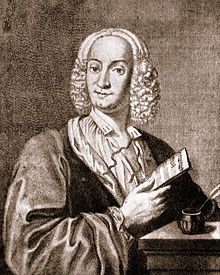Concerto alla rustica
| |
|---|---|
| by Antonio Vivaldi | |
 The composer | |
| Key | G major |
| Catalogue | RV 151 |
| Genre | Late Baroque |
| Form | Concerto |
| Composed | Mid-1720 to 1730 |
| Movements | 3 |
| Scoring | String orchestra and continuo, two oboes in the finale |
The Concerto for Strings in G major, RV 151, commonly referred to as the Concerto alla rustica (Italian: Rustic Concerto),[1] is a concerto for orchestra without soloists by the Italian composer Antonio Vivaldi. It was written between mid-1720 and 1730 and is one of Vivaldi's best-known concertos.
Composition
This concerto, unlike some other of Vivaldi's concertos, included no detailed descriptive programme.[2] It was presumably composed between mid-1720 and 1730. It was at that time when Vivaldi was working with his Contest Between Harmony and Invention, Op. 8, from which Vivaldi's Four Seasons were later better known.[3] The manuscript of this concerto was written partially on the same paper as Vivaldi's chamber version of the Goldfinch Concerto, Il Gardellino, RV 90b. Both of these concertos were supplied to the Ottoboni family in Rome.[4]
Structure
The concerto is in three movements and takes between 5 and 6 minutes to perform. It is scored for a string orchestra and continuo, including two oboes in the final movement. The movement list is as follows:
- Presto
- Adagio
- Allegro
The concerto starting movement is a moto perpetuo, a virtuoso piece for a Baroque orchestra in G major, and veers to G minor towards the final bars of the movement. Some commentators have acknowledged the anticipation of the later Viennese practice of the minor key conclusion. The second movement is a slow, contrasting movement playing long chords. The third movement, however, is a dance-like, swift movement. This last movement emphasizes the sharpened fourth degree of the scale (C sharp), therefore using a Lydian mode, a trait that was typically used in folk music. This feature was probably known to Vivaldi thanks to the sonatas and concertos in the Polish style by Vivaldi's contemporary Georg Philipp Telemann.[5]
In popular culture
Given that this is one of Vivaldi's best known concertos, it has been featured in several movies and TV series, among them:
- All That Jazz
- In 2005 Argentinian movie El Aura, by Fabián Bielinsky.[6]
- In "Mijo," the second episode of the American series Better Call Saul, created by Vince Gilligan.[7]
References
- ^ "Antonio Vivaldi (1678 – 1741)". Music Files Ltd. Retrieved 31 March 2015.
- ^ "About this Recording 8.550056 - VIVALDI: 4 Seasons (The) / Concerto alla Rustica (Liner Notes of Naxos 8.550056)". naxos.com. Naxos Digital Services. Retrieved 31 March 2015.
- ^ "ANTONIO LUCIO VIVALDI (1678-1741)". Retrieved 31 March 2015.
- ^ Talbot, Michael. "Vivaldi: Cantatas, Concertos & Magnificat (Liner Notes of Hyperion Records 55190)" (PDF). Hyperion Records. Retrieved 31 March 2015.
- ^ Malone, Andrew Lindemann. "Antonio Vivaldi Concerto alla rustica, for strings & continuo in G major, RV 151". allmusic.com. Rovi Corporation. Retrieved 31 March 2015.
- ^ "El aura (2005) Soundtracks". imdb.com. IMDb.com. Retrieved 31 March 2015.
- ^ "Better call Saul (TV Series) Mijo (2015) Soundtracks". imdb.com. IMDb.com. Retrieved 31 March 2015.
